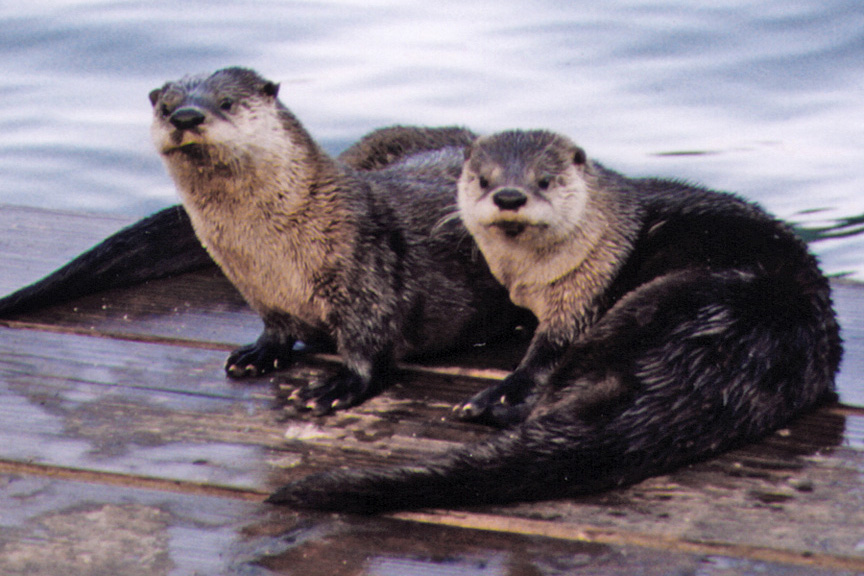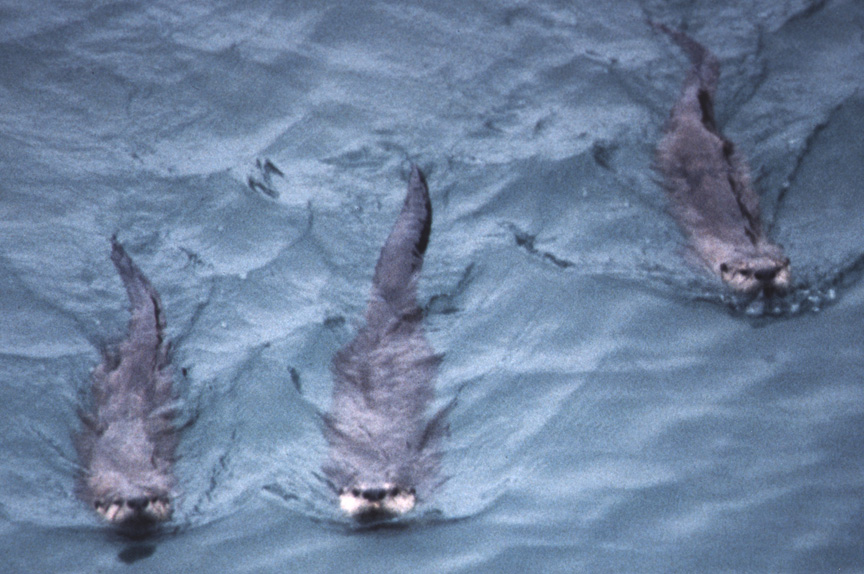Identifying Individual Otters, Page 2
byJ Scott Shannon

Meet "OM" and "Cleo" - two otters from the San Juan Islands in Puget Sound, Washington state. This is a mother/daughter pair observed back in the 1970s by Dr. Timothy Ransom. Tim is a heck of a lot better photographer than I am, so I'm going to use his pictures to give the first examples of the most important and reliable facial characteristics I use to tell one otter from another.
Look at the area under each otter's nose. OM (left) has what almost looks like a black mustache between the bottom of her nose and her upper lip. Notice that Cleo (right) has no such marking under her nose - I call otters like Cleo "plain faced". OM's mark is an example of what I call "mustachial maculations," or in less technical terms, "muzzle spots." These dark markings are not found on young otters; the marks appear and grow darker as an individual ages. Some individuals, like Cleo, may never develop these maculations, and as you'll see later, the lack of such markings can greatly complicate the process of identification.
Anyway, because of OM's prominent and unique facial marking, Tim never had any problem telling OM from Cleo, and I'm sure you wouldn't have any problem telling them apart, either. In my own population, the brothers "Ninety" and "Giant" (below) were examples of two otters which were very easy to tell apart on the basis of their mustachial marks (or the lack thereof).

If you have several otters in a group that have these markings, though, it becomes a little more of a challenge to tell one from another. An additional complication is that, on the same otter, these mustachial maculations can look different depending on whether the individual is wet or dry, whether the sunlight is direct or diffuse, or if the otter has its head turning one way or another. The spots can also change over time, usually becoming progressively darker with age. But if you make up for this by observing the animal repeatedly when it's wet and dry, in direct and diffuse sunlight, and you observe it over a period of weeks and months and years, you can recognize the mustachial mark of a particular individual quite reliably. Continuity of observations over long periods of time is essential for this technique to work, however. I didn't start to have real confidence in my ability to reliably identify all the individuals here until 4 or 5 years after my study began. Also, binoculars with a minimum magnification of 10x are required to discriminate enough detail between the mustachial maculations of similarly-marked individuals. In my experience, anything less than 10x simply won't suffice.
There's another type of mustachial maculation that can facilitate individual recognition. Look at this picture of Little Mama (below, center).

See that bright white spot under Mom's nose? She was the only adult in the population who had this distinctive "headlight," so this made Little Mama extremely easy to keep track of, especially when she was wet. These white maculations actually start out as bright orange spots on the muzzle of some baby otters. The spots stay orange until about age 3, then become white spots on mature otters. Around age 10, Little Mama's black mustachial maculations eventually obscured her white spot, but her almost solid black face was also very distinct from any other otter here. All her life, Little Mama was always the easiest otter to identify in this population.
Click here to continue...
[Home] [Previous Page] = 2 = [Next Page]
Text and Photographs Copyright © 2005-2025 by J Scott Shannon, All Rights Reserved. Contact:
